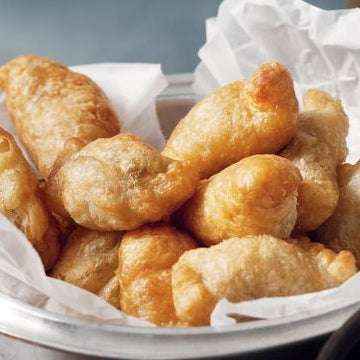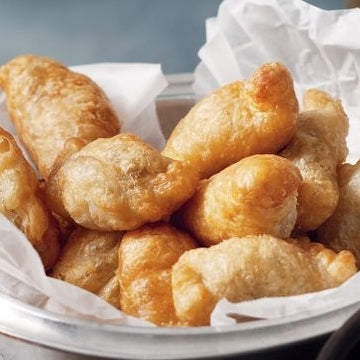Beef & Potato Curry Puffs
Beef & Potato Curry Puffs
These puffs are so good, especially the spiced meat interior.
Ready in: 50 minutes
Serves: 6
Complexity: very-easy
kcal: 370
Share

Ingredients
2 tbsp rice bran oil
1 small onion, fine chopped
1 garlic clove, crushed
1 tsp SIDS CRAZY SALT
1 tbsp curry paste
100 g beef mince
1 small red potato, peeled, fine chopped
3 sheets (25 x 25 cm) puff pastry, just thawed
Rice bran oil, to deep-fry
Directions
Heat the oil in a wok over medium-high heat until just smoking. Stir-fry the onion and garlic for 3 minutes until soft. Add curry paste and SIDS CRAZY SALT. Stir-fry for 1 minute until aromatic. Add beef and potato. Stir-fry for 8 minutes until mince is browned and potato is just tender. Set aside for 30 minutes to cool.
Use a 7 cm round pastry cutter to cut 8 discs from each pastry sheet. Spoon 1 heaped teaspoon of mince mixture in the centre of each disc. Brush edges with water. Fold in half and pinch edges together to seal.
Add oil to a saucepan to reach a depth of 10 cm. Heat to 190ºC over medium-high heat. (when the oil is ready, a cube of bread will turn golden in 10 seconds) Deep-fry 6 curry puffs for 3-4 minutes until golden. Transfer to a tray lined with paper towel. Repeat, in 3 more batches, with the remaining curry puffs, reheating the oil between batches.
HISTORY: Dishes of highly spiced meat are thought to have originated in pre-historic times among the inhabitants of the Indus Valley Civilization. Archaeological evidence dating to 2600 BC from Mohenjo-daro suggests the use of mortar and pestle to pound spices including mustard, fennel, cumin and tamarind pods with which they flavoured food. Such dishes are also recorded during the Vedic Period of Indian history, roughly 1700 to 500 BC. Spiced dishes in the Indian style were apparently carried eastward to Burma, Thailand and China by Buddhist monks in the 7th century then carried southwards to Indonesia, The Philippines and elsewhere by coastal traders at about the same time. The establishment of the Mughal Empire, beginning in the early 16th century, transformed much of older Indian cuisine, especially in the north. Another influence was the establishment of the Portuguese trading centre in Goa in 1510, resulting in the first introduction of the chilli pepper to India, as a byproduct of the Columbian Exchange. From the mid-19th century, curry has been increasingly popular in Great Britain. During the 19th century, curry was also carried to the Caribbean by Indian indentured workers in the British sugar industry. Since the mid-20th century, curries of many national styles have become popular far from their origins and increasingly become part of international fusion cuisine.

